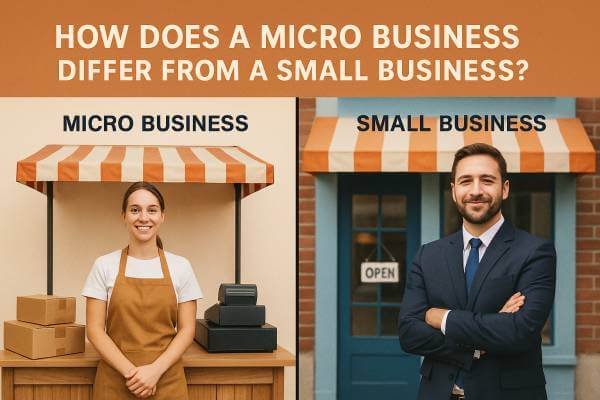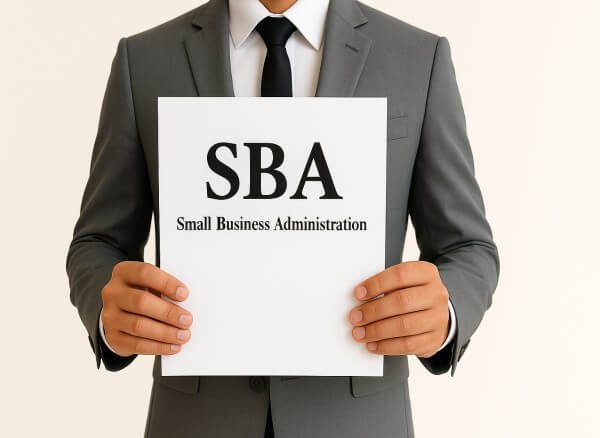How Does a Micro Business Differ from a Small Business?
If you’ve ever wondered about the difference between a micro business vs. a small business, you’re not alone. Many entrepreneurs, side hustlers, and freelancers ask this same question when trying to figure out where their business fits. The truth is, these two terms sound pretty similar, but they don’t always mean the same thing.
A microbusiness is usually even smaller than what most people think of when they hear “small business.” We’re talking about solo entrepreneurs, home-based businesses, or teams with just a few people. On the other hand, a small business can have dozens or even hundreds of employees and still meet the official size limits.
Knowing whether you’re running a micro business or a small business matters more than you think. It can affect your funding, operations, and growth resources.
In this article, we’re breaking it all down. We’ll look at what counts as a micro business, how it compares to a small business, and why understanding the difference could save you time and money as you grow.
What Is a Micro Business?
Microbusiness is basically the smallest type of business out there. It is considered as one that is extremely lean, has minimal overhead, and typically operates with just one person. If you’re a freelancer, an Etsy shop owner, a consultant, or running a local service business with just a couple of helpers, you’re probably operating a micro business, even if you didn’t realize it.
Most micro businesses have:
- Fewer than 10 employees (often just one or two)
- Very limited revenue, usually under $250,000 to $500,000 a year
- Simple operations, often run from home or online
- One person making most of the decisions (that’s probably you)
These businesses are super common, especially among solo entrepreneurs and side hustlers. They’re usually built for independence, flexibility, or extra income, not necessarily for rapid growth or big teams. That doesn’t mean they’re any less real or important, though. Micro businesses make up a huge chunk of the economy and often lead to bigger ventures down the line.
If you’re doing it all yourself or keeping things intentionally small, you’re likely running a microbusiness.
What Is a Small Business?
You’ve probably seen the term everywhere, from SBA loans to tax documents, but it covers a much broader range than most people think.
A small business is usually defined by
- Having fewer than 500 employees (sometimes less, depending on the industry)
- Generating revenue under $41.5 million, based on SBA standards
- Being independently owned and operated
- Not being dominant in its field (in other words, not a major corporation)
A small business can still be pretty big. It could be a local bakery with five employees, a construction company with 150 workers, or even a regional software firm pulling in millions a year. If your business fits within the SBA size standards for your industry, you’re in the small business category.
The key difference is that small businesses include a wide range of company sizes, from solo operations to mid-size teams. Micro businesses, on the other hand, sit on the tiny end of that scale.
Key Differences: Micro Business vs Small Business
At a glance, a micro business might look like a small business, but there are some clear differences once you dig into the details. Let’s compare the two to help you determine where your business truly fits.
1. Team Size
- Micro business: Usually has fewer than 10 employees, and often just one or two people (sometimes it’s just the owner).
- Small business: Can have anywhere from 10 to 500 employees, depending on the industry.
2. Revenue
- Micro businesses usually generate under $250,000 to $500,000 per year.
- Small businesses can earn up to $41.5 million annually and still qualify under SBA standards.
3. Business Structure
- Micro businesses are often sole proprietorships, single-member LLCs, or part-time ventures.
- Small businesses are more likely to have a formal structure with departments, systems, and possibly multiple owners or investors.
4. Operations
- Microbusinesses usually keep things simple and flexible, often run from home or online.
- Small businesses might have physical locations, staff, equipment, and more formal processes.
5. Growth Goals
- Micro businesses are often built around lifestyle or independence.
- Small businesses may aim for long-term growth, hiring, and expansion.
Here’s a quick comparison:
| Feature | Micro Business | Small Business |
| Team Size | Fewer than 10 | Up to 500 |
| Revenue | Under $500K | Up to $41.5 million |
| Business Type | Solo, home-based, flexible | Structured, scalable |
| Typical Example | Freelancer, Etsy shop | Restaurant, agency, retail store |
Pros and Cons of Running a Micro Business
Running a micro business can be incredibly rewarding, but like anything else, it comes with trade-offs. If you’re thinking about staying small on purpose, here’s a look at what works in your favour and what might slow you down.
Pros of a Micro Business
1. Low Overhead: You don’t need a fancy office, a huge team, or a big inventory. This feature significantly simplifies and reduces the cost of starting a business.
2. Full Control: As the owner, you make all the decisions. You don’t have to deal with layers of management or wait for approvals.
3. Flexibility: You can pivot quickly, set your own hours, and design your business around your lifestyle, not the other way around.
4. Easier to Manage: With fewer moving parts, you don’t need complex systems or big budgets. You can stay focused on what you do best.
5. Less Risk: With fewer expenses and lower revenue targets, there’s usually less financial pressure than running a larger business.
Cons of a Micro Business
1. Limited Resources: You may not have the budget or staff to scale quickly or take on larger projects.
2. Harder to Access Funding: Some loans and investors prefer businesses with bigger growth potential. Micro businesses often rely on personal savings or small loans.
3. No Built-In Backup: If you’re sick or need time off, the business might pause unless you’ve got support lined up.
4. Can Be Isolating: Working solo can get lonely. Without a team, you might miss out on collaboration and outside input.
Running a micro business is ideal for people who want freedom, control, and a lean setup. But if you’re aiming for rapid growth or want to build a team, you might outgrow the micro stage eventually, and that’s totally okay.
Do microbusinesses qualify for small businesses’ benefits?
Yes, they often do. Although micro businesses are classified as small, they can still access many of the same resources that larger small businesses utilize. The key is knowing where to look and making sure your business is properly registered. Some of the benefits include the following:
1. SBA Loans and Microloans
The Small Business Administration (SBA) offers a special Microloan Program designed for businesses that need smaller amounts of funding, usually up to $50,000. These loans are perfect for microbusinesses that may not qualify for traditional financing.
2. Grants and Local Funding
Some grants, especially from local governments or nonprofit organizations, are tailored for tiny businesses and solo entrepreneurs. These are often focused on helping underrepresented groups, startups, or home-based businesses.
3. Tax Benefits
Micro businesses can still claim business deductions, such as home office expenses, internet and phone bills, equipment, and travel. As long as you’re making money and tracking expenses, you’re eligible.
4. Free Business Resources
Organizations like SCORE, Small Business Development Centers (SBDCs), and Women’s Business Centers offer free coaching, workshops, and tools, even for businesses of one.
5. Government Contracts (Sometimes)
If your micro business is properly registered and meets small business size standards, you may still be able to compete for contracts, especially in niches with less competition.
Being small doesn’t mean you’re out of the game. Many programs don’t require a minimum employee count, and some are actually designed with micro businesses in mind.
Is Your Business a Microbusiness?
Do you have doubts about your business’s eligibility as a micro business? Use this quick checklist to find out. If you check most of these boxes, there’s a good chance you’re operating at the micro level:
- You have fewer than 10 employees (or maybe just yourself)
- Your business brings in less than $500,000 in annual revenue
- You run the business independently and make most of the decisions
- You work from home or a small office, with low overhead
- Your business is not part of a larger corporation or franchise
- You handle multiple roles—marketing, sales, admin, and customer service
- You started with little to no outside funding
- You don’t plan to scale rapidly or seek venture capital
- You offer a niche service or product, often to local or online customers
If this sounds like you, you’re likely a micro business owner. This does not mean that micro businesses are inferior to larger, more traditional businesses. In fact, microbusinesses make up a huge portion of the economy and are some of the most agile and creative out there.
Conclusion
Where does your business stand in the micro business vs small business conversation? If you’re running things solo or with a tiny team, working with a modest budget, and keeping things simple, you’re probably in the micro business camp. And that’s a wonderful place to be.
Understanding the difference between a micro business and a small business isn’t just about labels. It helps you make smarter decisions, know what resources you qualify for, and build a business that fits your goals, whether that means staying lean or eventually growing into something bigger.
Micro businesses are flexible, independent, and easier to manage. You don’t need a huge staff or a massive budget to be successful. You just need the right tools, a clear plan, and the confidence to own your role as a business owner.
Want to keep learning? Check out our guide on how to grow your micro business without losing your freedom or explore the best tools for solo entrepreneurs.
Frequently Asked Questions
What is the difference between a micro business and a small business?
A micro business typically has fewer than 10 employees and lower revenue (often under $500,000), while a small business can have up to 500 employees and generate millions annually. One person or a very small team with limited resources typically runs micro businesses.
Can a freelancer be considered a micro business?
Yes. If you’re a freelancer, consultant, or solo entrepreneur running your own for-profit business, you’re likely operating as a microbusiness. Even without employees, you still qualify.
Do I need to register my micro business?
That depends on your state and how you operate. In many cases, micro businesses still need to register with local or state authorities, especially if they use a business name, sell products, or offer services. You may also need a business license or tax ID.
Are micro businesses eligible for small business loans or grants?
Yes. Many microbusinesses qualify for SBA microloans, local grants, and other funding programs. The key is to meet the basic requirements, like being a for-profit business and falling under the size limits.
Can a microbusiness grow into a small business?
Absolutely. Many successful companies start out as microbusinesses. As you bring in more revenue, hire employees, or expand your operations, your business can move into the small business category while still keeping its original mission and values.









